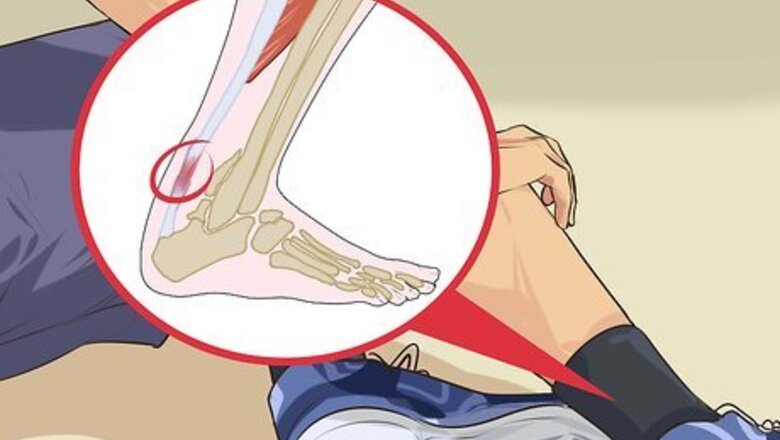
views
X
Research source
Tendinitis can cause significant pain and disability, although it often fades away after a few weeks, particularly if some helpful home care treatment is applied. Anti-inflammatory medications like aspirin and ibuprofen can help treat tendonitis by reducing swelling and pain. Light stretches can also help relieve symptoms. However, in some cases, tendonitis can become chronic and requires medical attention.
Home Remedies
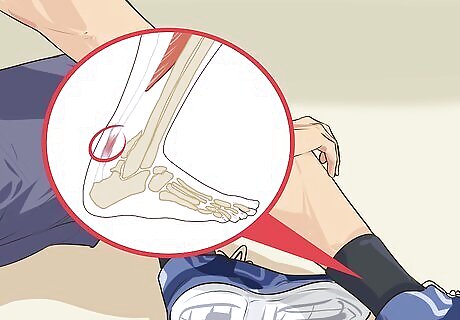
Stop overusing the tendon/muscle. Inflamed tendons can be caused by a sudden injury, but they're usually triggered by small, repetitive movements over the course of many days, weeks or months. Repetitive motions put stress on the tendons, which creates micro-tears and localized inflammation. Identify what action is creating the problem and either take a break from it (at least a few days) or modify the movement somehow. If the tendonitis is work related, then talk to your employer about temporarily switching to a different activity. If your problem is exercise related, then you may be working out too aggressively or with improper form — consult with a personal trainer. Playing too much tennis and golf are common causes of elbow joint tendinitis, thus the terms "tennis elbow" and "golfer's elbow." Acute tendonitis will usually heal itself if you give your body a chance to rest, but if you don't, it can become a chronic (ongoing) problem that's much more difficult to treat.
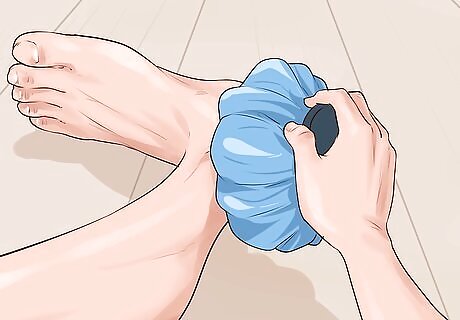
Apply some ice to the inflamed tendon. The pain from tendonitis is primarily due to inflammation, which is an attempt by the body to heal and protect the injured tissue. However, the body's inflammatory response is usually too much and actually contributes to the problem, so controlling it is key to reducing the symptoms. As such, apply an icepack, frozen gel pack or bag or even a bag of frozen veggies to your inflamed tendon in order to reduce inflammation and dull the pain. Apply cold therapy every few hours until the pain and inflammation subside. If the inflammation is in smaller, more exposed tendons/muscles (such as the wrist or elbow), then apply the ice for about 10 minutes. If it's a larger or deeper tendon/muscle (such as the shoulder or hip), then leave the ice on for closer to 20 minutes. While you're icing the inflamed tendon, elevate the area and compress it by tying a Tensor or Ace bandage around the area — both techniques more efficiently combat inflammation. Don't forget to wrap ice up in a thin cloth before your apply it, as it will prevent negative reactions such as ice burn or frostbite.
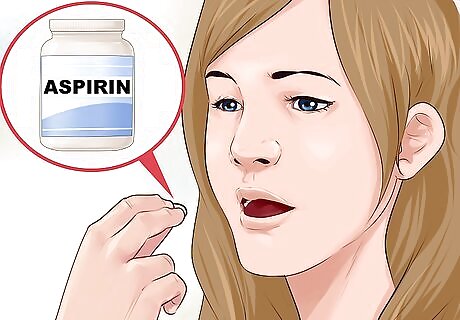
Take anti-inflammatory pills. Another method of combating the inflammation of tendonitis is by the use of over-the-counter nonsteroidal anti-inflammatory drugs (NSAIDs). NSAIDs such as aspirin, ibuprofen (Advil, Motrin) and naproxen (Aleve) help control the body's inflammation reaction, which reduces swelling and pain. NSAIDs tend to be hard on the stomach (and the kidneys and liver to a lesser extent), so it's best not take them for much longer than two weeks for any particular injury. As an alternative to pills, consider applying an anti-inflammatory/pain-relieving cream or gel to your inflamed tendon, especially if it's close to the skin's surface where it can be absorbed and have a greater impact. Avoid the use of painkillers (acetaminophen) or muscle relaxers (cyclobenzaprine) for your symptoms, because they don't address inflammation.
Stretches and Braces
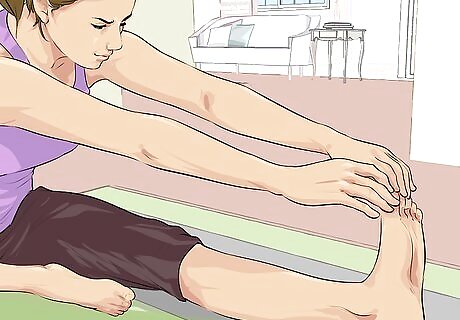
Lightly stretch the inflamed tendon. Mild-to-moderate tendonitis and muscle strains often respond well to stretching because it relieves muscle tension, promotes circulation and increases flexibility and range of motion. Stretching is applicable for acute tendonitis (as long as the pain/inflammation is not severe), chronic tendonitis and as a preventative measure. While stretching, use slow, steady movements and hold the positions for 20 – 30 seconds; repeat three to five times daily, especially before and after intense activity. For chronic tendonitis or as an injury prevention strategy, apply moist heat to the affected area before stretching it because the muscles and tendons will be warmed up and more flexible. Keep in mind that the pain of tendonitis is usually worse at night and after movement or activity.
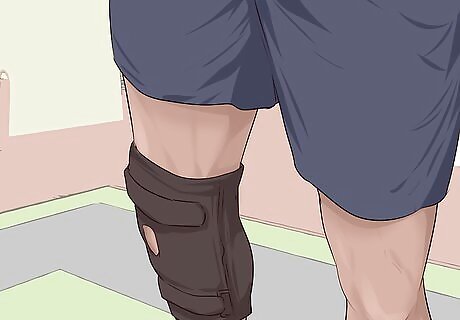
Wear a supportive brace. If the tendonitis involves your knee, elbow or wrist, then consider wearing a flexible neoprene sleeve or more supportive nylon/Velcro brace in order to help protect the area and limit movement. Wearing a support or brace also helps to remind you to take it easy and not overdo it while at work or in the gym. However, complete immobility of an inflamed area is not recommended either because tendons, muscles and related joints need some movement to get consistent blood circulation in order to heal properly. In addition to wearing a support, examine the ergonomics of your work area and make sure it suits your size and body type. If need be, adjust your chair, keyboard and desktop to alleviate excessive stress on your joints and tendons.
Professional Treatments
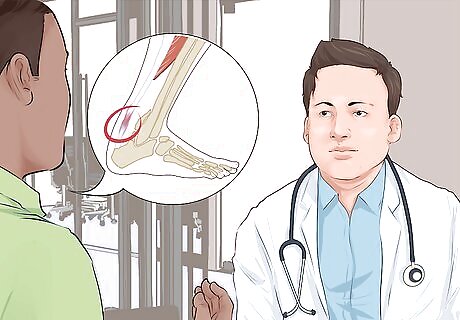
Consult with your doctor. If your tendonitis isn't going away and hasn't responded very well to rest and basic home care, then see your doctor for a physical examination. Your doctor will assess the severity of your tendonitis, sometimes using diagnostic equipment such as ultrasound or MRI, and give you recommendations. If the tendon has torn away from the bone (ruptured), then a referral to an orthopedic surgeon for surgical repair will be necessary. For less serious situations, rehabilitation and/or steroid injections are often more appropriate. Most surgeries for severe tendonitis is performed arthroscopically, by inserting a small camera and miniature instruments through small incisions close to joints. For chronic tendonitis, focused aspiration of scar tissue (FAST) is a minimally invasive surgery that removes scar tissue from the tendon without irritating the healthy tissue.
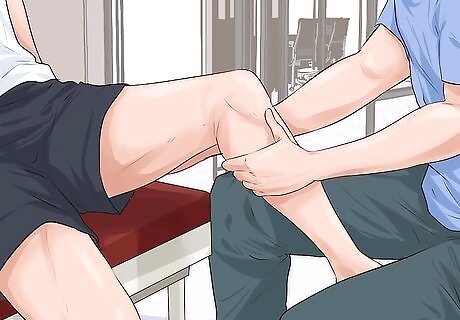
Get a referral for rehabilitation. If your tendonitis is a chronic condition, but not particularly serious, then your doctor will likely refer you for rehabilitation, such as physiotherapy. A physical therapist will show you specific and tailored stretches and strengthening exercises for your affected tendon and surrounding musculature. For example, eccentric strengthening — which involves contraction of a muscle/tendon while it's lengthening — is effective in treating chronic tendonitis.. Physical therapy is usually required two to three per week for four to eight weeks to positively impact chronic tendonitis. Physical therapists can also treat inflamed tendons with therapeutic ultrasound or micro-current, both proven to help relieve inflammation and stimulate healing. Some physical therapists (and other medical professionals) use low-energy light waves (infrared) to decrease inflammation and pain in mild-to-moderate musculoskeletal injuries.
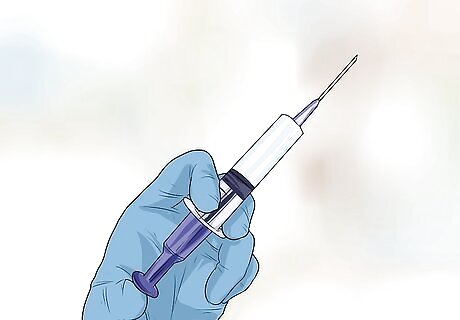
Get an steroid injection. If your doctor thinks it's warranted, he may recommend a steroid injection into or near your inflamed tendon. Steroids such as cortisone are very effective at reducing inflammation in a short period of time, which can eliminate pain and restore mobility (at least short-term), but there are risks to be aware of. In rare cases, corticosteroid injections can further weaken the injured tendon and cause it to tear. As such, corticosteroid injections are not recommended repeatedly for tendinitis lasting over three months because it increases the risk of tendon ruptures. Steroid injections provide short-term pain relief, but may not have long-term success. In addition to tendon weakening, other side effects associated with steroid injections include infection, local muscle atrophy, nerve damage and reduced immune function. If steroid injections fail to resolve the tendonitis, particularly if it's in conjunction with physical therapy, then some form of surgery should be considered.
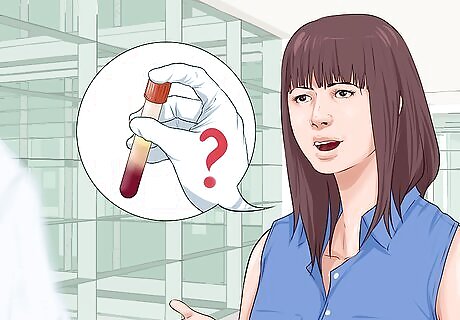
Ask your doctor about platelet-rich plasma (PRP) therapy. PRP treatment is relatively new and still being studied, but it involves taking a sample of your blood and spinning it to separate out the platelets and various healing factors from the red blood cells. The plasma mixture is then injected into chronically inflamed tendon(s), which is reported to reduce inflammation and boost tissue healing. If effective, PRP would be a much better alternative to corticosteroid injections due to the lack of side effects. As with any invasive procedure, there always exists risks of infection, excessive bleeding and/or the build-up of scar tissue.

















Comments
0 comment